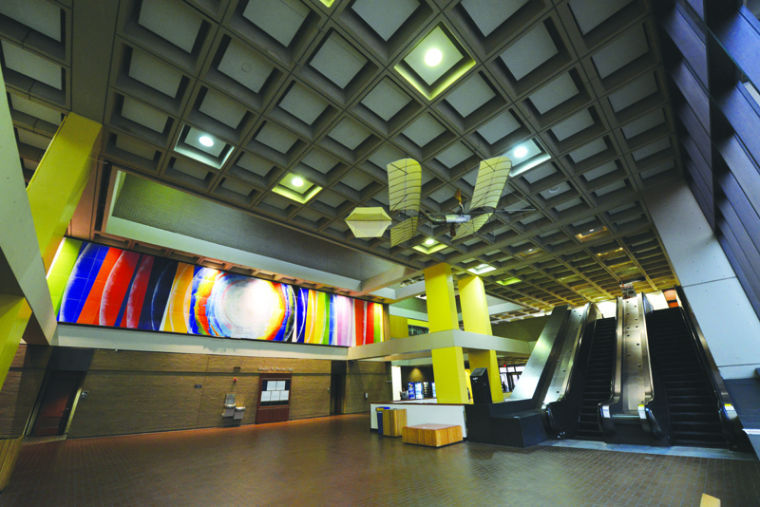That’s brutal: A history of Posvar Hall’s architectural stylings
December 3, 2013
When Chitra Sharma first toured Pitt as a prospective student, she saw Wesley W. Posvar Hall on a Pitt Pathfinders tour. At the time, she didn’t think that the building was particularly remarkable — nothing about it stuck out as memorable to her. Now, about two and a half years later, Sharma still finds Posvar Hall a relative oddity on Pitt’s campus.
“Now that I’ve seen so many other Pitt buildings, I think that Posvar has a really strange build and shape,” said Sharma, a junior studying finance and business information systems. “It isn’t like some of the older-looking buildings, and it just sticks out.”
As the largest academic building on Pitt’s campus, Posvar Hall does stick out. But not many people know why the building is as massive as it is. And even fewer know that this hulking building is the product and a prime example of Brutalist architecture, an architectural fad that swept through U.S. college campuses in the 1960s and 1970s.
Posvar Hall’s Construction
Originally called the Forbes Quadrangle until 2000, Posvar Hall is named after Wesley W. Posvar, the 15th chancellor of the University, who is best known for creating the University Honors College and the University Center for Social and Urban Research during his tenure.
The building’s construction started in 1975 and ended in 1978. The exterior of the 744,695-square-foot building is made primarily of limestone panels, which were common in Brutalist work. Interestingly, the building’s architecture actually combines prominent areas of poured concrete — one of the most common features of Brutalist work — with areas of limestone.
That’s one of the problems Franklin Toker — a professor in Pitt’s history of art and architecture department — has with Posvar Hall. Toker is critical of much of the building’s design and construction. He said he tells his students the price differential between the two materials — limestone and concrete — is so large that it doesn’t make sense to have non-uniform materials.
Toker said that the national excitement over the use of poured concrete in architecture had dissipated by the time construction began on Posvar Hall in 1975.
“The excitement of a poured-concrete building in 1948 is hardly going to be the case of a building opening in 1974 or so, so it’s a generational issue,” he said.
Although it might seem strange that poured concrete was used in addition to the limestone panels of Posvar Hall’s exterior, there is a clear reason as to why it was done: Brutalist architecture was very popular when Posvar Hall was being built.
Brutalist Architecture
The Brutalist style of architecture originated with the European architect Le Corbusier. After World War II, Le Corbusier decided to divert from the then-standard methods of architectural design. At that point, Modernism was the principal architectural style, and it emphasized simplistic, unadorned construction.
Le Corbusier adopted poured concrete as his preferred method of exterior construction, and this became one of the most telling signs of Brutalist work.
Poured concrete, Toker said, “is really the soul of Brutalism.” This technique was used in place of cut stone, and one of its most identifying traits is the residual sign of construction. This usually takes the form of hundreds of holes on the sides of the building, which are indicative of the texture of the wooden or metal frames used to place the concrete.
“The old style was to rub it smooth and paint it,” Toker said, “and Le Corbusier said, ‘No, no, no. This is part of the act of creation.’”
Le Corbusier’s methods were picked up and continued in the future construction of many buildings.
John Conti, a freelance writer for the Pittsburgh Tribune-Review, who writes about architecture and the preservation of historical spaces, said that Brutalist buildings were still built after the initial excitement over them had faded, because Le Corbusier’s style was revered by academics.
He said that architects taught Brutalism in colleges in the 1960s and 1970s because it was “the trendy thing” among the academic architecture community. And although there are some Brutalist houses, museums and public buildings, the style was predominantly used in university settings.
“And some people say that’s because the academics were excited by Le Corbusier and the new forms that he created — in this case — by using concrete,” Conti said.
Posvar Hall’s Brutalist Exterior
Posvar Hall’s poured-concrete and limestone exterior is telling of its Brutalist design. After being laid between beams that framed the concrete and gave it shape, the concrete was then poured and took the shape of its surroundings. This method was used in lieu of a more common practice of stacking individual blocks on top of each other as the only architectural method implemented.
Another of Posvar Hall’s most noticeably Brutalist features is its blocky appearance. The construction of Brutalist buildings is traditionally bulky and massive, with large overhangs often jutting out of the building.
As one of his critical observations of the building’s Brutalist roots, Toker noted that though the Posvar Hall overhang facing Bigelow Boulevard can, in the event of rain, keep pedestrians dry, there isn’t much other purpose for such a large structural piece. It’s confusing, Toker said, that the overhang exists without any function beyond shielding passers-by from the elements.
He described the building as one of “giganticism,” remarking on the building’s colossal stature. He also said that Posvar Hall is muscle-bound. But, he asks, “Huge muscularity leading to what?”
“It’s unclear … And all of these years later, it’s still confusing. I think because the building never explains itself, or the basis for certain decisions,” he said.
Posvar Hall’s Brutalist Interior
Students who enter Posvar Hall from the entrance on Bigelow Boulevard are immediately greeted by a huge open space with elevators and doors to classrooms on the sides.
In his writings on the building, Conti has described Posvar Hall as “awkward” and “ungainly.” He questioned whether or not the building makes efficient use of its massive amount of space.
For Sharma, this space can’t be used for much else aside from the student dance teams who practice there — the only example of which she could think of a practical application of the expanse.
“Like I said, I think some student organizations can utilize that space. Other than that, I don’t really think it’s necessary for there to be such open space on the first floor,” she said. “I mean, they [could] have made classrooms bigger, or put more classrooms in, or made different rooms that weren’t for classrooms, like maybe recreational rooms.”
For Tom Tymon, a Pitt senior majoring in biology, Posvar Hall’s predominantly open space sets it apart from many other University buildings in a good way.
Tymon said the building’s loping design provides many spots for doing work, and it doesn’t cramp people together.
“There are lots of nooks and crannies that you can find and work in here,” he said. “It’s not like the library, where you just feel all of this pressure.”
Toker is significantly less fond of the building’s internal organization.
“The ceilings on the first floor are very tall, but not effectively tall,” he said, noting the Brutalist-inspired open space of Posvar Hall. “They’re simply tall, but there’s no joyousness you would feel from a tall Renaissance church ceiling or something.”
Brutalism’s Legacy in Posvar Hall
Conti said that after Brutalism — which was a detraction from Modernism — had its 15 minutes of fame in the academic community, it was soon replaced by a new style: Postmodernism. In this style, architects actively try to make buildings that fit in with already-existing architecture, Conti said.
One example of architecture built in the Postmodernist style is PPG Place, a complex of six buildings located Downtown. Postmodern buildings made greater use of columns and vertical structures, as demonstrated in PPG Place’s clean, upward construction.
This shift back toward columnal, high-rise architecture was meant to be an aesthetic change, rather than an alteration made out of technological necessity: Postmodern architecture wasn’t meant to be ornate or showy, but rather economical and practical.
“Those kinds of buildings have obviously been more popular than the Brutalist buildings,” Toker said. “Many of the Brutalist buildings like Posvar Hall simply weren’t well done,” he said.
The lingering unpopularity of the Brutalist style still affects how people feel about its manifestations.
“Somehow, I walk into Posvar and I get the sense of ‘Big Brother knows best,’ which is an irritating prospect,” Toker said. “Nobody likes that idea.”
He said that this may stem from the time in which the building was designed and built — the 1960s and 1970s. To him, that time period was “a moment of tension between ‘Big Brother knows best’ and everyday people saying, ‘What about me? I have my own facilities, my own intelligence.’”
To him, Posvar Hall seems “dictating.” But it also has a utilitarian purpose: The building pulls together all of the social science departments and puts them under one roof, which was needed at the time of the building’s construction, he said. Since the Cathedral of Learning houses the humanities and the administration and middle-campus buildings contain the sciences, there was a need somewhere for the “orphaned” social sciences, as Toker described them, to go. This need for a large shared academic building played a role in determining the size of the building.
For some, Tymon included, big isn’t necessarily bad. He likes that the building is spread outward instead of upward, unlike many other buildings on campus.
Sharma said that in the past she had tried to study in Posvar Hall, but she wasn’t pleased with the experience.
“I didn’t like it. It was lonely, because it’s such a big building and it always seems empty after classes let out.”
Since there’s no consensus on whether or not the building is built in a way amenable to day-to-day activities, it’s difficult to make a decisive statement on Posvar Hall.
But for Toker, there’s one thing about it that pleases him.
“My end feeling is that luckily, just about all the University of Pittsburgh buildings built since Posvar have been superior,” he said. “So I take comfort in that.”



